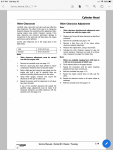Mad Dog
Turbocharged
I developed a cam cover gasket leak and decided yesterday was the day to take it apart. Figured I would check valve clearances while I was in there. I spent a couple of hours fiddling with it checking and rechecking until I duplicated previous results. I was careful to align each cam lobe directly over center of the bucket and made the feeler gauge as snug as I judged was possible without compressing the spring. Here is what I got:

I’m not a mechanic or a machinist, I don’t use a feeler gauge frequently, and know enough to know it’s a skill I don’t have, so like I said I went slow and repeated the process until I got consistent results. Unless I misjudged and did compress the springs trying to get a snug fit, I’ve got around 50% more clearance than Triumph specs.
I really am not wanting to pull the cams. I’ve read about @Rocket Scientist & @Bedifferent making tools to compress the springs and change shims, haven’t spotted anything on the tools recently, what’s the latest, are they still considered a viable alternative?
I also found this video of a guy working on a Yamaha who stuck a zip tie in the spark plug hole and worked it in an open valve to hold the bucket down while he rotated the cam into the closed position, skip to 12:20 for the pertinent part Zip tie method
@Speedy @warp9.9 @R-III-R Turbo @Claviger @Idaho Red Rocket 3 anybody else have some input?
I’ve got a 4 day run coming up in 2 weeks and RAA west in September, I’m inclined to not put it back together until it’s corrected, but don’t have the time tools or parts to get it done in 2 weeks, how far can I push this (if any) and exactly what damage am I risking?
I’m not a mechanic or a machinist, I don’t use a feeler gauge frequently, and know enough to know it’s a skill I don’t have, so like I said I went slow and repeated the process until I got consistent results. Unless I misjudged and did compress the springs trying to get a snug fit, I’ve got around 50% more clearance than Triumph specs.
I really am not wanting to pull the cams. I’ve read about @Rocket Scientist & @Bedifferent making tools to compress the springs and change shims, haven’t spotted anything on the tools recently, what’s the latest, are they still considered a viable alternative?
I also found this video of a guy working on a Yamaha who stuck a zip tie in the spark plug hole and worked it in an open valve to hold the bucket down while he rotated the cam into the closed position, skip to 12:20 for the pertinent part Zip tie method
@Speedy @warp9.9 @R-III-R Turbo @Claviger @Idaho Red Rocket 3 anybody else have some input?
I’ve got a 4 day run coming up in 2 weeks and RAA west in September, I’m inclined to not put it back together until it’s corrected, but don’t have the time tools or parts to get it done in 2 weeks, how far can I push this (if any) and exactly what damage am I risking?
Last edited by a moderator:

